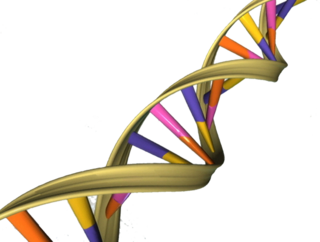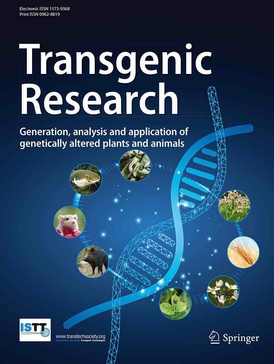
In vitro studies are performed with microorganisms, cells, or biological molecules outside their normal biological context. Colloquially called "test-tube experiments", these studies in biology and its subdisciplines are traditionally done in labware such as test tubes, flasks, Petri dishes, and microtiter plates. Studies conducted using components of an organism that have been isolated from their usual biological surroundings permit a more detailed or more convenient analysis than can be done with whole organisms; however, results obtained from in vitro experiments may not fully or accurately predict the effects on a whole organism. In contrast to in vitro experiments, in vivo studies are those conducted in living organisms, including humans, known as clinical trials, and whole plants.
Molecular biology is the study of chemical and physical structure of biological macromolecules. It is a branch of biology that seeks to understand the molecular basis of biological activity in and between cells, including biomolecular synthesis, modification, mechanisms, and interactions.

Max Ludwig Henning Delbrück was a German–American biophysicist who participated in launching the molecular biology research program in the late 1930s. He stimulated physical scientists' interest into biology, especially as to basic research to physically explain genes, mysterious at the time. Formed in 1945 and led by Delbrück along with Salvador Luria and Alfred Hershey, the Phage Group made substantial headway unraveling important aspects of genetics. The three shared the 1969 Nobel Prize in Physiology or Medicine "for their discoveries concerning the replication mechanism and the genetic structure of viruses". He was the first physicist to predict what is now called Delbrück scattering.

Reverse transcription polymerase chain reaction (RT-PCR) is a laboratory technique combining reverse transcription of RNA into DNA and amplification of specific DNA targets using polymerase chain reaction (PCR). It is primarily used to measure the amount of a specific RNA. This is achieved by monitoring the amplification reaction using fluorescence, a technique called real-time PCR or quantitative PCR (qPCR). Combined RT-PCR and qPCR are routinely used for analysis of gene expression and quantification of viral RNA in research and clinical settings.
BioMed Central (BMC) is a United Kingdom-based, for-profit scientific open access publisher that produces over 250 scientific journals. All its journals are published online only. BioMed Central describes itself as the first and largest open access science publisher. It was founded in 2000 and has been owned by Springer, now Springer Nature, since 2008.
The first isolation of deoxyribonucleic acid (DNA) was done in 1869 by Friedrich Miescher. DNA extraction is the process of isolating DNA from the cells of an organism isolated from a sample, typically a biological sample such as blood, saliva, or tissue. It involves breaking open the cells, removing proteins and other contaminants, and purifying the DNA so that it is free of other cellular components. The purified DNA can then be used for downstream applications such as PCR, sequencing, or cloning. Currently, it is a routine procedure in molecular biology or forensic analyses.
Springer Science+Business Media, commonly known as Springer, is a German multinational publishing company of books, e-books and peer-reviewed journals in science, humanities, technical and medical (STM) publishing.

A plasmid preparation is a method of DNA extraction and purification for plasmid DNA, it is an important step in many molecular biology experiments and is essential for the successful use of plasmids in research and biotechnology. Many methods have been developed to purify plasmid DNA from bacteria. During the purification procedure, the plasmid DNA is often separated from contaminating proteins and genomic DNA.
Current Protocols is a series of laboratory manuals for life scientists. The first title, Current Protocols in Molecular Biology, was established in 1987 by the founding editors Frederick M. Ausubel, Roger Brent, Robert Kingston, David D. Moore, Jon Seidman, Kevin Struhl, and John A. Smith of the Massachusetts General Hospital Department of Molecular Biology and the Harvard Medical School Departments of Genetics and Biological Chemistry, and Sarah Greene of Greene Publishing Associates The Current Protocols series entered into a partnership with Wiley-Interscience, John Wiley and Sons, was acquired by Wiley in 1995, and continued to introduce additional titles. Scientists contribute methods that are peer-reviewed by one of 18 editorial boards. The core content of each title is updated quarterly, and new material is added. In 2009, the Current Protocols website was launched, with online versions of all of the texts, research tools, video protocols, and a blog. Several Current Protocols titles are indexed in MEDLINE and searchable by PubMed: CP Molecular Biology, CP Immunology, CP Cell Biology, CP Protein Science, CP Microbiology.
In natural and social science research, a protocol is most commonly a predefined procedural method in the design and implementation of an experiment. Protocols are written whenever it is desirable to standardize a laboratory method to ensure successful replication of results by others in the same laboratory or by other laboratories. Additionally, and by extension, protocols have the advantage of facilitating the assessment of experimental results through peer review. In addition to detailed procedures, equipment, and instruments, protocols will also contain study objectives, reasoning for experimental design, reasoning for chosen sample sizes, safety precautions, and how results were calculated and reported, including statistical analysis and any rules for predefining and documenting excluded data to avoid bias.
Cold Spring Harbor Laboratory Press was founded in 1933 to aid in Cold Spring Harbor Laboratory's purpose of furthering the advance and spread of scientific knowledge.
The phage group was an informal network of biologists centered on Max Delbrück that contributed heavily to bacterial genetics and the origins of molecular biology in the mid-20th century. The phage group takes its name from bacteriophages, the bacteria-infecting viruses that the group used as experimental model organisms. In addition to Delbrück, important scientists associated with the phage group include: Salvador Luria, Alfred Hershey, Seymour Benzer, Charles Steinberg, Gunther Stent, James D. Watson, Frank Stahl, and Renato Dulbecco.

Karen B. Avraham is an Israeli-American human geneticist and the first female Dean of the Tel Aviv University's Faculty of Medicine. Born in Canada in 1962, Avraham moved to the US at a young age. Her research focuses on the discovery and characterization of genes responsible for hereditary hearing loss.

Artificial gene synthesis, or simply gene synthesis, refers to a group of methods that are used in synthetic biology to construct and assemble genes from nucleotides de novo. Unlike DNA synthesis in living cells, artificial gene synthesis does not require template DNA, allowing virtually any DNA sequence to be synthesized in the laboratory. It comprises two main steps, the first of which is solid-phase DNA synthesis, sometimes known as DNA printing. This produces oligonucleotide fragments that are generally under 200 base pairs. The second step then involves connecting these oligonucleotide fragments using various DNA assembly methods. Because artificial gene synthesis does not require template DNA, it is theoretically possible to make a completely synthetic DNA molecule with no limits on the nucleotide sequence or size.
Humana Press was an American academic publisher of science, technology, and medical books and journals founded in 1976. It was bought by Springer Science+Business Media in 2006.
Springer Protocols was a database of life sciences protocols published by Springer Science+Business Media. It replaced BioMed Protocols, a Humana Press database, in January 2008, and was deactivated on 25 July 2018. The protocols were then available on the SpringerLink website.
Kürşad Türkşen is a senior scientist in chronic disease at Ottawa Health Research Institute and an assistant professor, biochemistry, University of Ottawa. Türkşen is also the editor-in-chief for the journal Stem Cell Reviews and Reports, published by Humana Press, and is an executive board member for Springer Protocols, an online database of research protocols published by Springer Science+Business Media. Türkşen studies skin cells at the molecular level hoping to develop new treatments for skin conditions, wounds, burns, and genetic skin diseases.
Immunosurgery is a method of selectively removing the external cell layer (trophoblast) of a blastocyst through a cytotoxicity procedure. The protocol for immunosurgery includes preincubation with an antiserum, rinsing it with embryonic stem cell derivation media to remove the antibodies, exposing it to complement, and then removing the lysed trophoectoderm through a pipette. This technique is used to isolate the inner cell mass of the blastocyst. The trophoectoderm's cell junctions and tight epithelium "shield" the ICM from antibody binding by effectively making the cell impermeable to macromolecules.

Transgenic Research, international in scope, is a bimonthly, peer-reviewed, scientific journal, published by Springer. The co-editors-in-chief are Johannes Buyel and Simon Lillico.






